신생아 땀띠(비립종/속립진/한진), Neonatal heat rashes
| 신생아 땀띠(비립종, 속립진, 한진)의 원인 |
- 피부의 표피층 속에 생긴 봉입성 피부 낭종을 땀띠, 비립종, 속립진, 또는 한진이라 한다.
- 피부에 에크린 땀샘들(그림 253참조)이 정상적으로 있다.
- 덥게 옷을 많이 입거나, 고열이 나거나 무슨 이유로든 체온이 갑자기 정상 이상으로 올라갈 때 에크린 땀샘들에서 땀이 날 수 있고 그로 인해 땀띠가 날 수 있다.
- 체온이 정상 이상으로 올라가면 에크린 땀샘에서 나온 땀이 에크린 땀샘 관로를 통과한 후 피부 표면에 있는 땀구멍을 통과해 피부층 표면으로 분비되고 그로 인해 체온이 적절하게 조절되는 것이 정상 생리이다.
- 땀띠는 박테리아 감염이나 바이러스 감염으로 생기지 않는다.
- 때로는 에크린 땀샘 관로와 땀구멍이 각질로 막힐 수 있다. 그래서 땀이 피부 표면위로 정상적으로 분비되지 못한다.
- 에크린 땀샘에서 분비된 땀이 에크린 땀샘 관로 속에 갑자기 많이 고이게 된다. 이럴 때 땀띠가 더 심하게 된다.
- 특히 실내 온도가 보통보다 높거나 여름철 같이 날씨가 습하고 무더우면 땀샘 구멍이 막혀 좁쌀만 한 맑은 물집이 땀샘 관로에 생겨 땀띠가 생길 때가 많다.
- 에크린 땀샘 관로 속에 고인 땀으로 생긴 작은 수포가 표피층에 생길 수 있고, 또 그 관로가 터져 붓고 빨개질 수 있다.
- 대부분의 땀띠의 직경은 1~2mm 이다. 어떤 땀띠는 그보다 조금 더 클 수 있다.
- 이런 땀띠가 한꺼번에 많이 날 수 있다. 때로는 서로 엉겨 붙어 날 수 있다.
- 에크린 땀샘이 있는 피부 어디든지 날 수 있다.
- 특히 목, 얼굴, 코, 앞이마, 머리, 가슴, 등, 가랑이, 기저귀 차는 부위에서 땀띠가 더 잘 난다.
| 신생아 땀띠(비립종, 속립진, 한진)의 종류 |
1. 맑은 물집이 잡힌 수정양 한진(Miliaria crystallina),
2. 흰색을 띤 백색 한진(Miliaria alba),
3. 분홍색을 띤 홍색 한진(Miliaria rubra),
4. 곪은 것 같은 농포성 한진(Pustula miliaria),
5. 심부 한진(Severe miliaria)
6. 그 외 등으로 분류된다.
- 땀띠에 세균(박테리아)감염이나 바이러스 감염, 또는 다른 종류의 병원체 감염은 잘 생기지 않는다.
- 박테리아 감염이 없을 때도 땀띠가 농포로 변화되기도 하고,
- 드물게, 박테리아 감염으로 땀띠가 노랗게 곪을 수 있다.
- 이런 땀띠를 농포성 땀띠(한진)라 한다.
- 땀띠가 박테리아 감염에 의해서 곪는 경우는 아주 드물다.
- 신생아기 이후 영유아들이 옷을 너무 덥게 입거나 담요 등을 너무 덥거나 다른 그 외 다른 원인으로 체온이 갑자기 올라가면 땀띠가 날 수 있다.
- 신생아들의 땀띠는 코 주위에 있는 피부에 더 잘 나고
- 실내 온도가 높지 않아도 날 수 있다.
- 수정양 한진은 신생아에게 더 잘 나지 않는다. [부모도 반의사가 되어야 한다-소아가정간호백과]-제 6권 신생아 성장 발육 양호 질환-신생아 땀띠 참조.
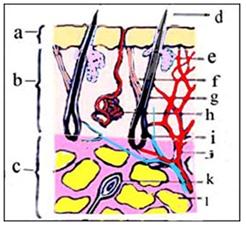
그림 252.피부 구조.
a-표피, b-진피, c-피하 조직, d-체모, e-피지선, f-발기근, g-모간, h-땀샘, i-모낭, j-모세 혈관, k-신경, l-피하 지방.
Copyrightⓒ 2001 John Sangwon Lee, MD., FAAP
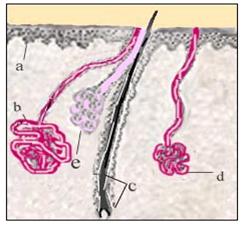
그림 253.피부와 땀샘.
a-표피층, b-아포크린 땀샘, c-모낭과 모발, d-에크린 땀샘, e-지방선.
Copyrightⓒ 2001 John Sangwon Lee, MD., FAAP
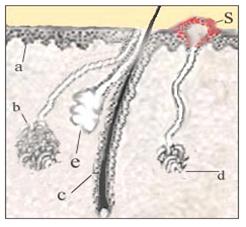
그림 255.홍색 한진(땀띠).
a-표피, b-아포크린 땀샘, c-모낭과 모발, d-에크린 땀샘, e-지방선, s-표피층 내 땀과 땀띠의 색. Copyrightⓒ 2001 John Sangwon Lee, MD., FAAP
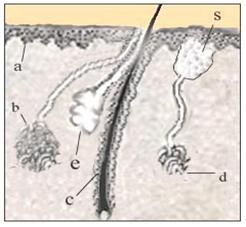
그림 256.심부 한진(땀띠).
a-표피, b-아포크린 땀샘, c-모낭과 모발, d-에크린 땀샘, e-지방선, s-진피 층층에 있는 땀.
Copyrightⓒ 2001 John Sangwon Lee, MD., FAAP
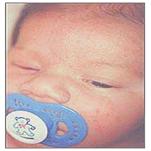
사진 257.수정양 한진(땀띠).
Copyrightⓒ 2001 John Sangwon Lee, MD., FAAP
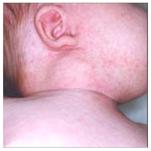
사진 258.홍색 한진(땀띠).
Copyrightⓒ 2001 John Sangwon Lee, MD.,FAAP

사진259.홍색 한진(땀띠).
Copyrightⓒ 2001 John Sangwon Lee, MD., FAAP
| 신생아 땀띠(비립종/속립진/한진)의 증상 징후 |
- 땀띠의 종류에 따라 증상 징후가 다르다.
- 땀띠의 색은 땀띠의 종류에 따라 백색이나 홍색 등이 있다.
- 땀띠가 난 피부가 약간 가려울 뿐 별다른 증상 징후가 생기지 않는다.
- 좁쌀만 한 물집이 잡히고 그 물집이 피부 표면위로 살짝 올라와 있다.
- 땀띠로 생긴 수포가 약간의 압력을 받으면 쉽게 터지면서 가려울 수 있으나 아프지는 않는 것이 보통이다.
- 수정양 땀띠는 목 부위나 겨드랑, 몸통 등에 주로 난다.
- 홍색 땀띠는 앞이마, 상체, 팔의 앞 부위 등에 주로 난다.
- 구진성 수포성 땀띠도 생기고 그 주위는 홍색을 띌 수 있고 때로는 조금 가렵다.
- 심부 땀띠(심부한진)는 열대지방 사람들에게 주로 날 수 있고 직경이 1~3mm이고 그렇게 가렵지 않다.
| 신생아 땀띠(비립종/속립진/ 한진)의 진단 치료 |
- 병력, 증상 징후와 진찰소견 등을 종합해 쉽게 진단할 수 있다.
- 겨울철이나 여름철에 두꺼운 담요 등으로 덥게 싸주거나 너무 꼭 싸주면 땀띠가 더 잘 날 수 있다.
- 실내 온도를 적절히 조절하고 너무 덥지 않게 옷을 입히고 너무 싸주지 말아야 한다.
- 적어도 1~3일에 한 번 정도 목욕을 시켜야 한다.
- 더운 여름철에는 가능한 한 옷을 시원하게 적절히 입혀 땀띠가 생기지 않게 예방해야 한다.
- 일단 난 땀띠는 특별히 치료해주지 않아도 1~2주 지나면 자연히 낫는다.
- 일반적으로, 땀띠가 곪아서 농가진이나 종기는 잘 생기지 않는다.
- 땀띠 난 피부에다 베이비파우더, 크림, 연고 등을 발라 치료해도 땀띠가 더 빨리, 더 잘 낫지 않는다.
- 때로는 그런 베이비파우더나 연고, 크림 등으로 피부가 자극받아 약물성 피부염이 생길 수 있고 땀샘 구멍이 더 잘 막혀 땀띠가 더 심해 질 수 있다.
- 칼라민 로션으로 치료하기도 하고 가려워하면 경구용 타이레놀 등 진통제로 치료하기도 한다.
- 박테리아 농포가 생기지 않는 한 땀띠를 항생제로 치료하지 않는다.
|
다음은 “땀띠, BCG 예방접종 ”에 관한 인터넷 소아청소년 건강상담 질의응답의 예 입니다. |
Q&A. 땀띠, BCG 예방접종 관해
Q.
태어난 지 25일째 되는 아기인데요.
태어난 날부터 땀띠가 이마와 머리에 생겼었는데 잘 없어지지 않고 있어요.
목욕을 하고 나서 신생아용 땀띠약을 발라주었는데 좀처럼 없어지지 않고 있습니다.
또 하나 질문은 BCG 예방접종에 관한 건데요.
소아과에서 맞히는 것과 보건소에서 맞히는 것이 어떤 차이점이 있는지 모르겠어요.
이미 맞힌 사람들 얘기를 들어보면 맞히는 방법은 다른 것 같은데 무슨 차이인지요?
A.
남원님
안녕하세요. 질문해 주셔서 감사합니다.
자녀의 나이, 성별, 과거 병력, 가족 병력, 진찰소견, 임상검사 등의 정보를 많이 알수록 답변을 드리는데 도움이 됩니다. 주신 정보를 토대로 해서 답변을 드리겠습니다.
땀띠를 참조하시기 바랍니다.
땀띠 치료 특효약도 없고 땀띠를 치료하지 않아도 그로 인해 건강상 큰 문제가 생기지 않는 것이 보통입니다.
어떤 국소용 땀띠약으로 땀띠를 치료하면 그 약물로 인해 오히려 피부염이 더 생겨 땀띠와 약으로 인한 피부염으로 더 고생을 할 수 있습니다.
아기에게 진짜로 땀띠가 났는지, 신생아 여드름, 아토피 피부염, 지루성 피부염 또는 다른 피부염이 있는지 감별 진단해야 합니다.
땀띠가 있으면 덥지 않게 양육하고 관찰적 치료를 하는 것이 치료의 전부입니다.
각 나라에 따라 기본 예방접종 방법이 어느 정도 일정합니다.
한국 기본 예방접종 방법에 따라 보건소에서도 동네 소아과 병원에서도 대학 병원 소아과에서도 거의 같은 방법으로 BCG 백신을 비롯한 다른 예방접종을 해 줄 것이라고 믿습니다.
소아청소년과에서 정기 건강검진을 받으시고 이런 문제에 관해서 상담하시기 바랍니다.
[부모도 반의사가 되어야 한다–소아가정간호백과]-제 2권 소아청소년 질병 안전사고- 예방-BCG 백신. 제 3권 신생아, 영유아, 학령기아, 사춘기아 성장 발육 육아–해당 연령의 성장 발육, 생후 1개월~6세 아이들의 발육 이정표. 제 4권 모유, 모유수유, 이유. 제 5권 인공영양, 우유, 이유식, 비타민, 미네랄, 단백질, 탄수화물, 지방.
질문이 더 있으면 다시 연락해 주시기 바랍니다. 감사합니다. 이상원 드림
Neonatal heat rashes 신생아 땀띠(비립종/속립진/한진)
Causes of neonatal heat rashes
- An enclosed skin cyst that develops in the epidermal layer of the skin is called a heat rash or milia.
- Eccrine sweat glands (see Figure 253) are normally present in the skin.
- When your baby wears a lot of clothes, has a high fever, or if your baby body temperature suddenly rises above normal for any reason, the eccrine glands can sweat and cause a sweat rash.
- When the body temperature rises above normal, it is normal physiology that sweat from the eccrine glands passes through the duct of the eccrine gland, then passes through the pores on the skin surface, and is secreted to the surface of the skin layer, whereby the body temperature is properly controlled.
- Heat rash does not result from a bacterial or viral infection.
- Occasionally, the Eccrine sweat gland ducts and pores can be clogged with dead skin cells.
- Therefore, sweat cannot be secreted normally on the skin surface.
- Sweat secreted from the eccrine glands suddenly accumulates in the eccrine glands. In this case, the heat rash becomes more severe.
- In particular, when the indoor temperature is higher than normal or when the weather is humid and hot, such as in summer, the sweat gland hole is blocked, and the gland-sized blisters are often formed in the sweat gland ducts, resulting in sweat rash.
- Small blisters caused by sweat accumulated in the eccrine sweat glands can form in the epidermis, and the ducts can burst and become swollen and red.
- The diameter of most sweat glands is 1-2mm.
- Some heat rashes can be a little bigger than that. This kind of heat rash can come out a lot at once.
- Sometimes they can stick together.
- Eccrine glands can fly anywhere on the skin.
- In particular, the neck, face, nose, front forehead, head, chest, back, crotch, and diapers are more prone to heat rash.
Types of heat rashes in newborns
1. Miliaria crystallina with clear blisters,
2. White Miliaria alba,
3. Pinkish red heat rashes (Miliaria Rubra),
4. Pustula miliaria,
5. Severe miliaria
6. Others are classified.
- Bacterial infections, viral infections, or other types of pathogen infections in the heat rash are less common.
- Even when there is no bacterial infection, sweat rashes can turn into pustules, Rarely, a bacterial infection can cause a yellow heat rash.
- This kind of heat rash is called pustular heat rash.
- It is very rare that the heat rash is infected by a bacterial infection. After the newborn, infants and toddlers can get a heat rash if their body temperature rises suddenly due to too hot clothes, blankets, etc., or other causes.
- Newborns’ heat rash is better on the skin around the nose
- Crystal heat rashes are less prone to newborn babies.
- [Parents should also be at least the half-doctors-Pediatrics and Family Nursing Encyclopedia]-Volume 6 Newborns with good growth and development disease-Refer to Newborn Heat Strain.

Figure 252. Skin structure. a-epidermis, b-dermis, c-subcutaneous tissue, d-body hair, e-sebaceous glands, f-erectile muscles, g-hair shaft, h-glands, i-hair follicles, j-capillaries, k-nerve, l-subcutaneous Fat. Copyrightⓒ 2001 John Sangwon Lee, MD., FAAP

- Figure 253. Skin and sweat glands. a-epidermal layer, b-apocrine glands, c-hair follicles and hair, d-eccrine glands, e-fat glands. Copyrightⓒ 2001 John Sangwon Lee, MD., FAAP

- Figure 255. Red heat rash. a-epidermis, b-apocrine sweat glands, c-hair follicles and hair, d-eccrine sweat glands, e-fat glands, s- the color of sweat and sweat glands in the epidermal layer. Copyrightⓒ 2001 John Sangwon Lee, MD., FAAP Figure

- 256. Deep heat rash. a-epidermis, b-apocrine glands, c-hair follicles and hair, d-eccrine glands, e-fat glands, s-perspiration in the dermal layer. Copyrightⓒ 2001 John Sangwon Lee, MD., FAAP

Photo 257: Sweat rash. Copyrightⓒ 2001 John Sangwon Lee, MD., FAAP

Picture 258: Heat rash Copyrightⓒ 2001 John Sangwon Lee, MD., FAAP

Picture 259: Heat rash. Copyrightⓒ 2001 John Sangwon Lee, MD., FAAP
Symptoms of neonatal heat rashes
- Symptoms and signs differ depending on the type of heat rash.
- The color of the heat rash can be white or red depending on the type of heat rash. The sweaty skin is a little itchy, but there are no signs of symptoms.
- Millet-sized blisters are caught, and the blisters are slightly raised above the surface of the skin.
- The blisters caused by the heat rash can burst easily and become itchy when subjected to a little pressure, but it is usually not painful.
- Crystal sweat rash mainly occurs in the neck, armpits, and torso.
- The red heat rash mainly occurs on the forehead, upper body, and front of the arm. A papular bullous sweat rash may also occur, and the area around it may be reddish and sometimes a little itchy.
- Deep heat rash (deep sweat rash) can fly mainly to people in the tropics and is 1 to 3 mm in diameter and not that itchy.
Diagnosis and treatment of neonatal heat rash
- It can be easily diagnosed by synthesizing the medical history, symptoms, and examination findings.
- In winter or summer, if you wrap it up warmly with a thick blanket or wrap it too tightly, you can get a better heat rash.
- Adjust the room temperature properly, dress up not to get too hot, and don’t pack too much.
- You should bathe at least once every 1-3 days. In the hot summer months, it is important to wear clothes as cool and appropriate as possible to prevent heat rash.
- First of all, the heat rash heals naturally after 1 to 2 weeks without any special treatment.
- In general, the heat rash is festering, so impetigo or boils are less common. Even if you apply baby powder, cream, ointment, etc. to the skin with heat rash, the heat rash does not heal faster and better.
- Sometimes such baby powders, ointments, and creams irritate the skin, which can lead to drug-related dermatitis, and the pores of the sweat glands are more blocked, which can lead to more severe sweating.
- It is sometimes treated with calamine lotion, and if itchy, it is treated with pain relievers such as oral Tylenol.
- Heat rashes are not treated with antibiotics unless bacterial pustules develop.
The following is an example of the Internet pediatric and adolescent health counseling question and answer on “heat rash, BCG vaccination”.
Q&A.
- Heat rash, BCG vaccination
Q.
- It’s the 25th day of birth.
- Since the day I was born, a heat rash has appeared on my forehead and hair, but it is not going away.
- After taking a bath, I applied sweat remedies for newborns, but it is not going away. Another question is about the BCG vaccination.
- I don’t know what’s the difference between guessing at a pediatrician and guessing at a public health center.
- If you hear about people who have already been right, the way to get it right seems to be different. What’s the difference?
A.
- Namwon Good morning. Thanks for asking.
- The more information you know about your child’s age, gender, past medical history, family medical history, medical examination findings, and clinical examination, the more helpful it is to give you an answer.
- We will respond based on the information you provided.
- Please refer to see Steam.
- There are no special treatments for heat rash, and even without treatment of heat rash, it usually does not cause major health problems.
- If you treat heat rash with some topical heat rash, the drug can cause more dermatitis, which can lead to more suffering from heat rash and dermatitis caused by the medicine.
- You should differentially diagnose whether your baby really has a heat rash, acne, atopic dermatitis, seborrheic dermatitis, or another dermatitis.
- If you have a heat rash, nurturing it so that it is not hot and performing the observational treatment is all of the treatment.
- Basic vaccination methods vary to some extent in each country.
- I believe that in accordance with the Korean basic vaccination method, the public health center, local pediatric hospital, and university hospital pediatrics will give you BCG vaccine and other vaccinations in almost the same way.
- Please take regular health check-ups at the Department of Pediatrics and Adolescents and consult about these issues.
- [Parents should also be at least the half-doctors-Child and Family Nursing Encyclopedia]-Volume 2 Child and Adolescent Disease Safety Accident-Prevention-BCG Volume 3 Newborns, Infants, School Age Hunger, Adolescents, Growth and Development Parenting-Growth and development of the relevant age, development milestones for children aged 1 month to 6 years old.
- Volume 4 Breastfeeding, Breastfeeding, Reasons. Volume 5 Artificial nutrition, milk, baby food, vitamins, minerals, protein, carbohydrates, fat.
- If you have more questions, please contact us again. Thank you. Lee Sang-won .MD
출처 및 참조 문헌
- NelsonTextbook of Pediatrics 22ND Ed
- The Harriet Lane Handbook 22ND Ed
- Growth and development of the children
- Red Book 32nd Ed 2021-2024
- Neonatal Resuscitation, American Academy Pediatrics
- www.drleepediatrics.com 제1권 소아청소년 응급 의료
- www.drleepediatrics.com 제2권 소아청소년 예방
- www.drleepediatrics.com 제3권 소아청소년 성장 발육 육아
- www.drleepediatrics.com 제4권 모유,모유수유, 이유
- www.drleepediatrics.com 제5권 인공영양, 우유, 이유식, 비타민, 미네랄, 단백질, 탄수화물, 지방
- www.drleepediatrics.com 제6권 신생아 성장 발육 육아 질병
- www.drleepediatrics.com제7권 소아청소년 감염병
- www.drleepediatrics.com제8권 소아청소년 호흡기 질환
- www.drleepediatrics.com제9권 소아청소년 소화기 질환
- www.drleepediatrics.com제10권. 소아청소년 신장 비뇨 생식기 질환
- www.drleepediatrics.com제11권. 소아청소년 심장 혈관계 질환
- www.drleepediatrics.com제12권. 소아청소년 신경 정신 질환, 행동 수면 문제
- www.drleepediatrics.com제13권. 소아청소년 혈액, 림프, 종양 질환
- www.drleepediatrics.com제14권. 소아청소년 내분비, 유전, 염색체, 대사, 희귀병
- www.drleepediatrics.com제15권. 소아청소년 알레르기, 자가 면역질환
- www.drleepediatrics.com제16권. 소아청소년 정형외과 질환
- www.drleepediatrics.com제17권. 소아청소년 피부 질환
- www.drleepediatrics.com제18권. 소아청소년 이비인후(귀 코 인두 후두) 질환
- www.drleepediatrics.com제19권. 소아청소년 안과 (눈)질환
- www.drleepediatrics.com 제20권 소아청소년 이 (치아)질환
- www.drleepediatrics.com 제21권 소아청소년 가정 학교 간호
- www.drleepediatrics.com 제22권 아들 딸 이렇게 사랑해 키우세요
- www.drleepediatrics.com 제23권 사춘기 아이들의 성장 발육 질병
- www.drleepediatrics.com 제24권 소아청소년 성교육
- www.drleepediatrics.com 제25권 임신, 분만, 출산, 신생아 돌보기
- Red book 29th-31st edition 2021
- Nelson Text Book of Pediatrics 19th- 21st Edition
- The Johns Hopkins Hospital, The Harriet Lane Handbook, 22nd edition
- 응급환자관리 정담미디어
- Pediatric Nutritional Handbook American Academy of Pediatrics
- 소아가정간호백과–부모도 반의사가 되어야 한다, 이상원 저
- The pregnancy Bible. By Joan stone, MD. Keith Eddleman, MD
- Neonatology Jeffrey J. Pomerance, C. Joan Richardson
- Preparation for Birth. Beverly Savage and Dianna Smith
- 임신에서 신생아 돌보기까지. 이상원
- Breastfeeding. by Ruth Lawrence and Robert Lawrence
- Sources and references on Growth, Development, Cares, and Diseases of Newborn Infants
- Emergency Medical Service for Children, By Ross Lab. May 1989. p.10
- Emergency care, Harvey Grant and Robert Murray
- Emergency Care Transportation of Sick and Injured American Academy of Orthopaedic Surgeons
- Emergency Pediatrics A Guide to Ambulatory Care, Roger M. Barkin, Peter Rosen
- Quick Reference To Pediatric Emergencies, Delmer J. Pascoe, M.D., Moses Grossman, M.D. with 26 contributors
- Neonatal resuscitation Ameican academy of pediatrics
- Pediatric Nutritional Handbook American Academy of Pediatrics
- Pediatric Resuscitation Pediatric Clinics of North America, Stephen M. Schexnayder, M.D.
-
Pediatric Critical Care, Pediatric Clinics of North America, James P. Orlowski, M.D.
-
Preparation for Birth. Beverly Savage and Dianna Smith
-
Infectious disease of children, Saul Krugman, Samuel L Katz, Ann A.
- 제4권 모유, 모유수유, 이유 참조문헌 및 출처
- 제5권 인공영양, 우유, 이유, 비타민, 단백질, 지방 탄수 화물 참조문헌 및 출처
- 제6권 신생아 성장발육 양호 질병 참조문헌 및 출처
- 소아과학 대한교과서
|
Copyright ⓒ 2015 John Sangwon Lee, MD., FAAP 미국 소아과 전문의, 한국 소아청소년과 전문의 이상원 저 “부모도 반의사가 되어야 한다”-내용은 여러분들의 의사로부터 얻은 정보와 진료를 대신할 수 없습니다. The information contained in this publication should not be used as a substitute for the medical care and advice of your doctor. There may be variations in treatment that your doctor may recommend based on individual facts and circumstances. “Parental education is the best medicine.” |